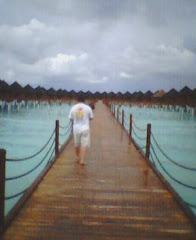Continuing my walk around the Kyu Furukawa Gardens. The notes are taken from the guide provided by the park.
旧古河庭園の散歩のつづき。庭園の案内は入り口で貰ったガードからです。
The Western-style Garden / 洋風庭園
Roses have been planted in the manner of a terraced garden and are in full bloom in the spring and fall (
it appears I was a bit early to see the flowers in bloom). This garden helps to set off the appearance of the Western-style residence and create the atmosphere of a foreign country.
Banksia roses cover the walls. They are a symbol closely associated with Mako, the daughter of Prince Akishi-no-no-miya (the younger brother of the crown prince).
テラス式の庭園に植えられたバラは、春と秋に見事な大輪の花を咲かせ洋館の風性と相まって異国情緒を満喫させてくれます。秋篠宮家の長女・眞子様のお印・「モッコウバラ(木香茨)が石垣をびっしりと覆っています。
From an observation point looking down into the Japanese garden.
展望台から眺める日本庭園。
You will find many different types of Japanese lanterns in the garden. This is an
Okunoin type garden lantern.
庭園にいろんな種類の灯篭が見れます。これは奥の院型灯篭。
Shinji-ike / 心字池
The pond was designed in the shape of the Japanese character for "heart". The pond was made using Kurama-Hira-ishi and Iyo-ao-ishi. The points from which the pond can be seen best include, in the front, the "funatsuki-ishi" (boatloading stone), the "araiso" (rugged shallows), the snow viewing stone lantern, the dry waterfall in front and also from the hill in the rear of the pond.
「心」の字に似せて鞍馬平いしや伊予青石などで造られた池。池を眺める要となる「船着石」があ、正面には「荒磯」、雪見灯篭、枯滝、石組み、そして背後には築山がみられます。
Otaki / 大滝
The large waterfall is more than 10m in height and originates on top of the steepest point in the garden, the upper part of which was further built up to make it higher. The front of the slope was dug away to make a cliff and the slope is covered with trees to create an illusion of a river gorge in the deep mountains. The flow curves and divides into smaller, lower level flows before dropping into a chasm.
10数mの高所から落ちる滝。園内のもっとも勾配の急な所をさらに削って断崖とし、濃い樹林でおおって深山渓谷の趣があります。曲折した流れから始まり、数段の小滝となり最後は深い淵に落ちるという造りです。
"Kuzure -shizumi" Wild Stone Wall / 崩石積
The sign reads "石を垂直に積む方法は数あるが、これは京都で発達した伝統的な工法である。石と石が噛み合って崩れそうで崩れない姿が美しいとされる。当庭園においても小川治兵衛(おがわじへい)の力作となっている”
Yet another Japanese lantern / また灯篭発見
A teahouse in the garden (reservations required) / 園内の茶室 (予約制)
Isn't hard to imagine that I'm in the bustling metropolis of Tokyo when you look at these pictures.
写真を見ると東京都内に居ると思いませんでしょう。
A closer view of the teahouse / 茶室に近づきました
Looks like I time-slipped to Edo / 江戸時代にタイムスリップした感じ
This garden isn't as large as Rikugien but it does make for a pleasant walk.
旧古河庭園は六義園ほど広くないですが、散歩には快適ですよ。
To be continued...
づづく。。。




























































.jpg)


